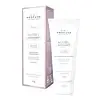What's inside
What's inside
 Key Ingredients
Key Ingredients

 Benefits
Benefits

 Concerns
Concerns

 Ingredients Side-by-side
Ingredients Side-by-side

Water
Skin ConditioningPanthenol
Skin ConditioningCetearyl Olivate
Propylheptyl Caprylate
EmollientGlycerin
HumectantPolymethylsilsesquioxane
Sorbitan Olivate
EmulsifyingSodium Acrylates Copolymer
4-T-Butylcyclohexanol
MaskingAlpha-Glucan Oligosaccharide
CleansingCyclopentasiloxane
EmollientEthylhexyl Olivate
Skin ConditioningPentylene Glycol
Skin ConditioningCaprylyl Glycol
EmollientCitric Acid
BufferingEthylene Brassylate
MaskingTocopheryl Acetate
AntioxidantTriethanolamine
BufferingLecithin
EmollientBisabolol
MaskingCaprylhydroxamic Acid
Pentaerythrityl Tetra-Di-T-Butyl Hydroxyhydrocinnamate
AntioxidantButylene Glycol
HumectantAllantoin
Skin ConditioningDisodium EDTA
Ocimum Sanctum Leaf Extract
Skin ConditioningSilybum Marianum Fruit Extract
Skin ConditioningHydroxymethoxyphenyl Decanone
Skin ConditioningPhenoxyethanol
PreservativePotassium Sorbate
PreservativeWater, Panthenol, Cetearyl Olivate, Propylheptyl Caprylate, Glycerin, Polymethylsilsesquioxane, Sorbitan Olivate, Sodium Acrylates Copolymer, 4-T-Butylcyclohexanol, Alpha-Glucan Oligosaccharide, Cyclopentasiloxane, Ethylhexyl Olivate, Pentylene Glycol, Caprylyl Glycol, Citric Acid, Ethylene Brassylate, Tocopheryl Acetate, Triethanolamine, Lecithin, Bisabolol, Caprylhydroxamic Acid, Pentaerythrityl Tetra-Di-T-Butyl Hydroxyhydrocinnamate, Butylene Glycol, Allantoin, Disodium EDTA, Ocimum Sanctum Leaf Extract, Silybum Marianum Fruit Extract, Hydroxymethoxyphenyl Decanone, Phenoxyethanol, Potassium Sorbate
Water
Skin ConditioningCyclopentasiloxane
EmollientGlycerin
HumectantDimethicone
EmollientSodium Polyacrylate
AbsorbentAlpha-Glucan Oligosaccharide
CleansingArnica Montana Flower Extract
MaskingTocopheryl Acetate
AntioxidantTrideceth-6
EmulsifyingDimethiconol
EmollientButylene Glycol
HumectantPentylene Glycol
Skin ConditioningDimethicone Crosspolymer
Emulsion StabilisingPEG/PPG-18/18 Dimethicone
EmulsifyingDMDM Hydantoin
PreservativeLaureth-23
CleansingHydroxyphenyl Propamidobenzoic Acid
Skin ConditioningPotassium Sorbate
PreservativeLaureth-4
EmulsifyingPhenoxyethanol
PreservativeSodium Hyaluronate
HumectantAscorbyl Palmitate
AntioxidantWater, Cyclopentasiloxane, Glycerin, Dimethicone, Sodium Polyacrylate, Alpha-Glucan Oligosaccharide, Arnica Montana Flower Extract, Tocopheryl Acetate, Trideceth-6, Dimethiconol, Butylene Glycol, Pentylene Glycol, Dimethicone Crosspolymer, PEG/PPG-18/18 Dimethicone, DMDM Hydantoin, Laureth-23, Hydroxyphenyl Propamidobenzoic Acid, Potassium Sorbate, Laureth-4, Phenoxyethanol, Sodium Hyaluronate, Ascorbyl Palmitate
 Reviews
Reviews

Ingredients Explained
These ingredients are found in both products.
Ingredients higher up in an ingredient list are typically present in a larger amount.
Alpha-Glucan Oligosaccharide is a prebiotic. It prevents harmful bacteria from growing on skin by keeping the skin's microbiome in balance.
Another benefit of this ingredient is its antioxidant properties. Antioxidants protect our skin from oxidative damage.
Butylene Glycol (or BG) is used within cosmetic products for a few different reasons:
Overall, Butylene Glycol is a safe and well-rounded ingredient that works well with other ingredients.
Though this ingredient works well with most skin types, some people with sensitive skin may experience a reaction such as allergic rashes, closed comedones, or itchiness.
Learn more about Butylene GlycolCyclopentasiloxane, or D5, is a silicone used to improve texture of products and trap moisture.
D5 is considered lightweight and volatile. Volatile means it evaporates quickly after application. Once evaporated, D5 leaves a thin barrier that helps keep skin hydrated.
It is also an emollient. Emollients help soften the skin and prevent water loss. Silicones create a silky texture in products. D5 helps other ingredients become more spreadable.
Studies show D5 is safe to use in skincare products. We recommend speaking with a skincare professional if you have concerns.
Learn more about CyclopentasiloxaneGlycerin is already naturally found in your skin. It helps moisturize and protect your skin.
A study from 2016 found glycerin to be more effective as a humectant than AHAs and hyaluronic acid.
As a humectant, it helps the skin stay hydrated by pulling moisture to your skin. The low molecular weight of glycerin allows it to pull moisture into the deeper layers of your skin.
Hydrated skin improves your skin barrier; Your skin barrier helps protect against irritants and bacteria.
Glycerin has also been found to have antimicrobial and antiviral properties. Due to these properties, glycerin is often used in wound and burn treatments.
In cosmetics, glycerin is usually derived from plants such as soybean or palm. However, it can also be sourced from animals, such as tallow or animal fat.
This ingredient is organic, colorless, odorless, and non-toxic.
Glycerin is the name for this ingredient in American English. British English uses Glycerol/Glycerine.
Learn more about GlycerinPentylene glycol is typically used within a product to thicken it. It also adds a smooth, soft, and moisturizing feel to the product. It is naturally found in plants such as sugar beets.
The hydrophilic trait of Pentylene Glycol makes it a humectant. As a humectant, Pentylene Glycol helps draw moisture from the air to your skin. This can help keep your skin hydrated.
This property also makes Pentylene Glycol a great texture enhancer. It can also help thicken or stabilize a product.
Pentylene Glycol also acts as a mild preservative and helps to keep a product microbe-free.
Some people may experience mild eye and skin irritation from Pentylene Glycol. We always recommend speaking with a professional about using this ingredient in your routine.
Pentylene Glycol has a low molecular weight and is part of the 1,2-glycol family.
Learn more about Pentylene GlycolPhenoxyethanol is a preservative that has germicide, antimicrobial, and aromatic properties. Studies show that phenoxyethanol can prevent microbial growth. By itself, it has a scent that is similar to that of a rose.
It's often used in formulations along with Caprylyl Glycol to preserve the shelf life of products.
Potassium Sorbate is a preservative used to prevent yeast and mold in products. It is commonly found in both cosmetic and food products.
This ingredient comes from potassium salt derived from sorbic acid. Sorbic acid is a natural antibiotic and effective against fungus.
Both potassium sorbate and sorbic acid can be found in baked goods, cheeses, dried meats, dried fruit, ice cream, pickles, wine, yogurt, and more.
You'll often find this ingredient used with other preservatives.
Learn more about Potassium SorbateTocopheryl Acetate is AKA Vitamin E. It is an antioxidant and protects your skin from free radicals. Free radicals damage the skin by breaking down collagen.
One study found using Tocopheryl Acetate with Vitamin C decreased the number of sunburned cells.
Tocopheryl Acetate is commonly found in both skincare and dietary supplements.
Learn more about Tocopheryl AcetateWater. It's the most common cosmetic ingredient of all. You'll usually see it at the top of ingredient lists, meaning that it makes up the largest part of the product.
So why is it so popular? Water most often acts as a solvent - this means that it helps dissolve other ingredients into the formulation.
You'll also recognize water as that liquid we all need to stay alive. If you see this, drink a glass of water. Stay hydrated!
Learn more about Water